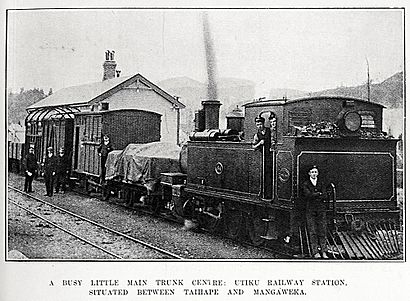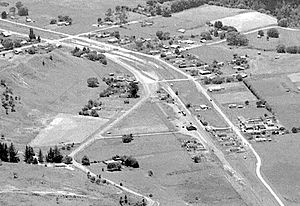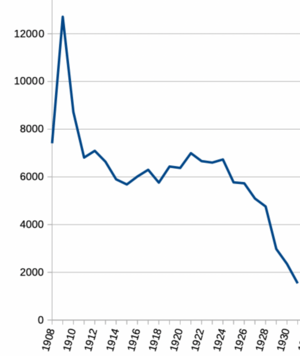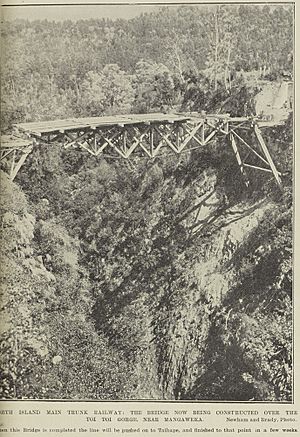Utiku railway station facts for kids
Quick facts for kids
Utiku railway station
|
|||||||||||
|---|---|---|---|---|---|---|---|---|---|---|---|

Utiku railway station in 1908
|
|||||||||||
| Location | New Zealand | ||||||||||
| Coordinates | 39°44′10″S 175°50′35″E / 39.736125°S 175.842999°E | ||||||||||
| Elevation | 371 m (1,217 ft) | ||||||||||
| Line(s) | North Island Main Trunk | ||||||||||
| Distance | Wellington 243.69 km (151.42 mi) | ||||||||||
| History | |||||||||||
| Opened | 27 May 1904 | ||||||||||
| Closed | Passengers 31 January 1982 Goods 31 October 1986 |
||||||||||
| Electrified | June 1988 | ||||||||||
| Services | |||||||||||
|
|||||||||||
Utiku railway station was an important stop on New Zealand's main railway line, the North Island Main Trunk. Located in the Manawatū-Whanganui region, it served trains from 1904 until 1986. The station was part of a 13.5-mile (21.7 km) section of track between Mangaweka and Taihape, officially opened by the Prime Minister, Richard Seddon, in 1904. Even though the station is closed, a special track called a passing loop is still there. The name Utiku comes from a biblical name, Eutychus.
Contents
Utiku Railway Station: A Look Back
Plans for the Utiku station began in 1902, as the railway line was being built towards the area. Construction tenders were announced in August 1903. By February 1904, tracks had reached the Toi Toi Viaduct.
Opening and Early Days
The 7.75-mile (12.5 km) railway extension from Mangaweka to Utiku opened for goods transport on May 27, 1904. The Public Works Department managed the trains at first. Goods could be sent all the way to Taihape starting August 4, 1904.
On September 10, 1904, Utiku opened for passengers as a flag station. This meant trains would only stop if someone waved a flag to get on or off. It had a simple shelter and a platform. A contract was signed to build the main station building, which was ready by February 1905.
Station Growth and Features
In 1906, a large goods shed was added, along with a loading area and yards for cattle and sheep. The station also got signals and a passing loop, which is a section of track that allows trains to pass each other. This loop was made longer in 1970 and again in 1980.
Because the station was getting busier, it was made larger in 1907, and a stationmaster was hired to manage it. A telephone was installed in 1909, making communication easier.
Traffic and Closure
Utiku was an important station, and its traffic was recorded each year. For example, in 1923, 6,599 passengers used the station. It was also a major hub for transporting sheep and pigs, and it had a significant trade in timber.
The station stopped serving passengers on January 31, 1982. It continued to receive Ravensdown fertilizer in large wagon loads until October 31, 1986, when it closed completely. In 2017, the ground near the station was strengthened using special techniques like shotcrete and soil nails.
Toi Toi Viaduct
The Toi Toi Viaduct is a large bridge located south of Utiku. It is 59 meters (194 feet) long and stands up to 58 meters (190 feet) above the Toi Toi Creek. The steel parts for the bridge were made by Scott Bros in Christchurch.
The viaduct was built using a cooperative system, where workers shared the responsibilities. It was finished in February 1904 and tested in September 1904. This viaduct is one of the few original ones from that time that are still in use, though it was made stronger in 1934. A newer section of the railway, called the Mangaweka deviation, starts just south of this viaduct.
Timber Industry at Utiku
When the railway first opened, the area around Utiku was covered in thick forests. Like other stations along this part of the North Island Main Trunk, Utiku played a big role in transporting timber from several sawmills.
Mill Sidings and Tramways
On May 11, 1904, even before the railway officially opened, a man named Albert Gibbs asked for a special side track (siding) at Utiku for his timber mill. In 1912, a cable on their tramway (a small railway for moving logs) broke. This caused the mill to close until a new bridge, mill, and tramway could be built in 1914. Similar accidents happened in 1904 and 1920, but thankfully no one was hurt. The 1914 bridge was replaced in 1961, and today only its northern tower remains. In 1922, the Gibbs Bros' factory, which made butter boxes, was destroyed by a storm. It finally burned down in 1927.
Another company, Knight's, had a siding north of the station from 1904. They planned a 7-mile (11 km) tramway to move timber. Perham & Larsen also had a mill north of Utiku until they moved to Rangataua in 1909. Both they and the Manawatu Timber Co had sidings at Utiku in 1906. As the forests were cut down, many mills closed. In 1909, there were nine mills, but by 1911, only two remained.




